Stress-Easing Effect of Diacyl Glyceryl Ethers on Anxiety-Related Behavior in Mice
Abstract
1. Introduction
2. Materials and Methods
2.1. Diacyl Glyceryl Ethers
2.2. Experimental Animals
2.3. Behavioral Assessments
2.3.1. Elevated Plus Maze Test
2.3.2. Open-Field Test
2.3.3. Forced Swimming Test
2.4. General Protocol
2.5. Statistical Analysis
2.5.1. Elevated Plus Maze
2.5.2. Open-Field Test
2.5.3. Forced Swimming Test
2.5.4. Changes in Body Weight per Food Intake
3. Results
3.1. Behavioral Assessments
3.1.1. Elevated Plus Maze Test
3.1.2. Open-Field Test
3.1.3. Forced Swimming Test
3.2. Changes in Body Weight per Food Intake
3.2.1. Elevated Plus Maze
3.2.2. Open-Field Test
3.2.3. Forced Swimming Test
4. Discussion
5. Conclusions
Author Contributions
Funding
Institutional Review Board Statement
Informed Consent Statement
Data Availability Statement
Acknowledgments
Conflicts of Interest
References
- Frautschy, S.A.; Cole, G.M. What was lost in translation in the DHA trial is whom you should intend to treat. Alzheimer’s Res. Ther. 2011, 3, 2. [Google Scholar] [CrossRef] [PubMed]
- Grosso, G.; Micek, A.; Marventano, S.; Castellano, S.; Mistretta, A.; Pajak, A.; Galvano, F. Dietary n-3 PUFA, fish consumption and depression: A systematic review and meta-analysis of observational studies. J. Affect. Disord. 2016, 205, 269–281. [Google Scholar] [CrossRef] [PubMed]
- Horikawa, C.; Otsuka, R.; Kato, Y.; Nishita, Y.; Tange, C.; Rogi, T.; Kawashima, H.; Shibata, H.; Ando, F.; Shimokata, H. Longitudinal association between n-3 long-chain polyunsaturated fatty acid intake and depressive symptoms: A population-based cohort study in Japan. Nutrients 2018, 10, 1655. [Google Scholar] [CrossRef]
- Hibbeln, J.R.; Nieminen, L.R.; Blasbalg, T.L.; Riggs, J.A.; Lands, W.E. Healthy intakes of n−3 and n–6 fatty acids: Estimations considering worldwide diversity. Am. J. Clin. Nutr. 2006, 83, 1483S–1493S. [Google Scholar] [CrossRef]
- Müller, C.P.; Reichel, M.; Mühle, C.; Rhein, C.; Gulbins, E.; Kornhuber, J. Brain membrane lipids in major depression and anxiety disorders. Biochim. Biophys. Acta. 2015, 1851, 1052–1065. [Google Scholar] [CrossRef] [PubMed]
- Saini, R.K.; Keum, Y.-S. Omega-3 and omega-6 polyunsaturated fatty acids: Dietary sources, metabolism, and significance—A review. Life Sci. 2018, 203, 255–267. [Google Scholar] [CrossRef]
- Burokas, A.; Arboleya, S.; Moloney, R.D.; Peterson, V.L.; Murphy, K.; Clarke, G.; Stanton, C.; Dinan, T.G.; Cryan, J.F. Targeting the microbiota-gut-brain axis: Prebiotics have anxiolytic and antidepressant-like effects and reverse the impact of chronic stress in mice. Biol. Psychiatry 2017, 82, 472–487. [Google Scholar] [CrossRef]
- Naeem, S.; Ali, L.; Rizwani, G.H.; Ikram, R.; Khan, S.S.; Shareef, H.; Younus, I.; Malick, T.Z.; Aleem, U. A comparative neurobehavioral study of sesame oil and fish oil on experimental animals. Pak. J. Pharm. Sci. 2020, 33, 511–521. [Google Scholar] [CrossRef]
- You, R.; Liu, Y.; Chang, R.C.-C. A behavioral test battery for the repeated assessment of motor skills, mood, and cognition in mice. J. Vis. Exp. 2019, 145, e58973. [Google Scholar] [CrossRef]
- Destaillats, F.; Bezelgues, J.-B.; Dionisi, F.; Cruz-Hernandez, C.; Masserey-Elmelegy, I. Method for Increasing Endogenous Plasmalogen Levels in Mammals. U.S. Patent 2011/0313039A1, 22 December 2011. Available online: https://patentimages.storage.googleapis.com/f5/16/9e/954f117729ae07/US20110313039A1.pdf (accessed on 22 December 2011).
- Engelmann, B. Plasmalogens: Targets for oxidants and major lipophilic antioxidants. Biochem. Soc. Trans. 2004, 32, 147–150. [Google Scholar] [CrossRef]
- Chua, E.C.-P.; Shui, G.; Cazenave-Gassiot, A.; Wenk, M.R.; Gooley, J.J. Changes in plasma lipids during exposure to total sleep deprivation. Sleep 2015, 38, 1683–1691. [Google Scholar] [CrossRef] [PubMed]
- Hagu, Y.A.N.; Yuka, T.; Masaya, K.; Sumio, K.; Kousei, N. Effect of a supplement product containing salmon roe oil-derived DHA and EPA and deep-sea shark liver oil-derived DAGE on the sleep quality and stress in healthy adults who have difficulties sleeping-a randomized, double-blind, placebo controlled, parallel group study. Jpn. Pharmacol. Ther. 2021, 49, 977–990. [Google Scholar]
- Pawlak, C.R.; Ho, Y.-J.; Schwarting, R.K. Animal models of human psychopathology based on individual differences in novelty-seeking and anxiety. Neurosci. Biobehav. Rev. 2008, 32, 1544–1568. [Google Scholar] [CrossRef] [PubMed]
- Komada, M.; Takao, K.; Miyakawa, T. Elevated plus maze for mice. J. Vis. Exp. 2008, 22, e1088. [Google Scholar] [CrossRef]
- Pawlak, C.R.; Karrenbauer, B.D.; Schneider, P.; Ho, Y.-J. The elevated plus-maze test: Differential psychopharmacology of anxiety-related behavior. Emot. Rev. 2012, 4, 98–115. [Google Scholar] [CrossRef]
- Gould, T.D.; Dao, D.T.; Kovacsics, C.E. The open field test. In Mood and Anxiety Related Phenotypes in Mice: Characterization Using Behavioral Tests; Gould, T.D., Ed.; Humana Press/Springer Nature: New York, NY, USA, 2009; pp. 1–20. [Google Scholar]
- Seibenhener, M.L.; Wooten, M.C. Use of the open field maze to measure locomotor and anxiety-like behavior in mice. J. Vis. Exp. 2015, 96, e52434. [Google Scholar] [CrossRef]
- Can, A.; Dao, D.T.; Arad, M.; Terrillion, C.E.; Piantadosi, S.C.; Gould, T.D. The mouse forced swim test. J. Vis. Exp. 2012, 59, e3638. [Google Scholar] [CrossRef]
- Porsolt, R.D.; Le Pichon, M.; Jalfre, M. Depression: A new animal model sensitive to antidepressant treatments. Nature 1977, 266, 730–732. [Google Scholar] [CrossRef]
- Tadano, T.; Abe, Y.; Morikawa, Y.; Hozumi, M.; Nakagawasai, O.; Tan-No, K.; Kisara, K. Relationship between learning behavior and genetic factor on immobility shown during forced swimming test. Nihon Shinkei Seishin Yakurigaku Zasshi 1997, 17, 129–135. (In Japanese) [Google Scholar]
- Albrechet-Souza, L.; Borelli, K.G.; Brandao, M.L. Activity of the medial prefrontal cortex and amygdala underlies one-trial tolerance of rats in the elevated plus-maze. J. Neurosci. Methods 2008, 169, 109–118. [Google Scholar] [CrossRef]
- Frussa-Filho, R.; Ribeiro, R.D.A. One-trial tolerance to the effects of chlordiazepoxide in the elevated plus-maze is not due to acquisition of a phobic avoidance of open arms during initial exposure. Life Sci. 2002, 71, 519–525. [Google Scholar] [CrossRef] [PubMed]
- Bolivar, V.J.; Caldarone, B.J.; Reilly, A.A.; Flaherty, L. Habituation of activity in an open field: A survey of inbred strains and F1 hybrids. Behav. Genet. 2000, 30, 285–293. [Google Scholar] [CrossRef] [PubMed]
- Gil, M.; Armario, A. Chronic immobilization stress appears to increase the role of dopamine in the control of active behaviour in the forced swimming test. Behav. Brain. Res. 1998, 91, 91–97. [Google Scholar] [CrossRef] [PubMed]
- Gershenfeld, H.K.; Neumann, P.E.; Mathis, C.; Crawley, J.N.; Li, X.; Paul, S.M. Mapping quantitative trait loci for open-field behavior in mice. Behav. Genet. 1997, 27, 201–210. [Google Scholar] [CrossRef] [PubMed]
- Cabib, S.; Puglisi-Allegra, S. Stress, depression and the mesolimbic dopamine system. Psychopharmacology 1996, 128, 331–342. [Google Scholar] [CrossRef]
- File, S.E.; Mabbutt, P.S.; Hitchcott, P.K. Characterisation of the phenomenon of “one-trial tolerance” to the anxiolytic effect of chlordiazepoxide in the elevated plus-maze. Psychopharmacology 1990, 102, 98–101. [Google Scholar] [CrossRef]
- Garcia-Marquez, C.; Armario, A. Chronic stress depresses exploratory activity and behavioral performance in the forced swimming test without altering ACTH response to a novel acute stressor. Physiol. Behav. 1987, 40, 33–38. [Google Scholar] [CrossRef]
- Carola, V.; D’Olimpio, F.; Brunamonti, E.; Bevilacqua, A.; Renzi, P.; Mangia, F. Anxiety-related behaviour in C57BL/6↔BALB/c chimeric mice. Behav. Brain. Res. 2004, 150, 25–32. [Google Scholar] [CrossRef]
- Pellow, S.; Chopin, P.; File, S.E.; Briley, M. Validation of open: Closed arm entries in an elevated plus-maze as a measure of anxiety in the rat. J. Neurosci. Methods 1985, 14, 149–167. [Google Scholar] [CrossRef]
- Walf, A.A.; Frye, C.A. The use of the elevated plus maze as an assay of anxiety-related behavior in rodents. Nat. Protoc. 2007, 2, 322–328. [Google Scholar] [CrossRef]
- Trullas, R.; Skolnick, P. Differences in fear motivated behaviors among inbred mouse strains. Psychopharmacology 1993, 111, 323–331. [Google Scholar] [CrossRef] [PubMed]
- Bello-Arroyo, E.; Roque, H.; Marcos, A.; Orihuel, J.; Higuera-Matas, A.; Desco, M.; Caiolfa, V.R.; Ambrosio, E.; Lara-Pezzi, E.; Gómez-Gaviro, M.V. MouBeAT: A new and open toolbox for guided analysis of behavioral tests in mice. Front. Behav. Neurosci. 2018, 12, 201. [Google Scholar] [CrossRef] [PubMed]
- Razzoli, M.; Carboni, L.; Andreoli, M.; Ballottari, A.; Arban, R. Different susceptibility to social defeat stress of BalbC and C57BL6/J mice. Behav. Brain. Res. 2011, 216, 100–108. [Google Scholar] [CrossRef] [PubMed]
- Consoli, D.; Contarino, A.; Tabarin, A.; Drago, F. Binge-like eating in mice. Int. J. Eat. Disord. 2009, 42, 402–408. [Google Scholar] [CrossRef]
- Groesz, L.M.; McCoy, S.; Carl, J.; Saslow, L.; Stewart, J.; Adler, N.; Laraia, B.; Epel, E. What is eating you? Stress and the drive to eat. Appetite 2012, 58, 717–721. [Google Scholar] [CrossRef]
- Sugimoto, Y.; Kajiwara, Y.; Hirano, K.; Yamada, S.; Tagawa, N.; Kobayashi, Y.; Hotta, Y.; Yamada, J. Mouse strain differences in immobility and sensitivity to fluvoxamine and desipramine in the forced swimming test: Analysis of serotonin and noradrenaline transporter binding. Eur. J. Pharmacol. 2008, 592, 116–122. [Google Scholar] [CrossRef]
- David, D.J.P.; Renard, C.E.; Jolliet, P.; Hascoët, M.; Bourin, M. Antidepressant-like effects in various mice strains in the forced swimming test. Psychopharmacology 2003, 166, 373–382. [Google Scholar] [CrossRef]
- Hamadate, N.; Shikura, M.; Mizukami, C.; Seto, K.; Yamamoto, T.; Yamagichi, H.; Izuka, M.; Yamamoto, E.; Kondo, S.; Yazawa, K. Effect of the deep sea shark-liver oil component food on secretion type immunoglobulin a density of saliva in the normal man and women adult. Jpn. Soc. Complement. Altern. Med. 2015, 12, 45–49. (In Japanese) [Google Scholar] [CrossRef]
- Das, A.K.; Hajra, A.K. High incorporation of dietary 1-O-heptadecyl glycerol into tissue plasmalogens of young rats. FEBS Lett. 1988, 227, 187–190. [Google Scholar] [CrossRef]
- Brohult, A.; Brohult, J.; Brohult, S.; Joelsson, I. Effect of alkoxyglycerols on the frequency of injuries following radiation therapy for carcinoma of the uterine cervix. Acta. Obstet. Gynecol. Scand. 1977, 56, 441–448. [Google Scholar] [CrossRef]
- Depino, A.M.; Gross, C. Simultaneous assessment of autonomic function and anxiety-related behavior in BALB/c and C57BL/6 mice. Behav. Brain. Res. 2007, 177, 254–260. [Google Scholar] [CrossRef] [PubMed]
- Carola, V.; D’Olimpio, F.; Brunamonti, E.; Mangia, F.; Renzi, P. Evaluation of the elevated plus-maze and open-field tests for the assessment of anxiety-related behaviour in inbred mice. Behav. Brain. Res. 2002, 134, 49–57. [Google Scholar] [CrossRef] [PubMed]
- Rogers, D.C.; Jones, D.N.; Nelson, P.R.; Jones, C.M.; Quilter, C.A.; Robinson, T.L.; Hagan, J.J. Use of SHIRPA and discriminant analysis to characterise marked differences in the behavioural phenotype of six inbred mouse strains. Behav. Brain. Res. 1999, 105, 207–217. [Google Scholar] [CrossRef] [PubMed]
- Anderzhanova, E.A.; Bächli, H.; Buneeva, O.A.; Narkevich, V.B.; Medvedev, A.E.; Thoeringer, C.K.; Wotjak, C.T.; Kudrin, V.A. Strain differences in profiles of dopaminergic neurotransmission in the prefrontal cortex of the BALB/C vs. C57Bl/6 mice: Consequences of stress and afobazole. Eur. J. Pharmacol. 2013, 708, 95–104. [Google Scholar] [CrossRef] [PubMed]
- File, S.E. The interplay of learning and anxiety in the elevated plus-maze. Behav. Brain. Res. 1993, 58, 199–202. [Google Scholar] [CrossRef]
- Su, J.; Hato-Yamada, N.; Araki, H.; Yoshimura, H. A test–retest paradigm of the forced swimming test in female mice is not valid for predicting antidepressant-like activity: Participation of acetylcholine and Sigma-1 receptors. J. Pharmacol. Sci. 2013, 123, 246–255. [Google Scholar] [CrossRef]
- Sugasini, D.; Thomas, R.; Yalagala, P.C.; Tai, L.M.; Subbaiah, P.V. Dietary docosahexaenoic acid (DHA) as lysophosphatidylcholine, but not as free acid, enriches brain DHA and improves memory in adult mice. Sci. Rep. 2017, 7, 11263. [Google Scholar] [CrossRef]
- Nguyen, L.N.; Ma, D.; Shui, G.; Wong, P.; Cazenave-Gassiot, A.; Zhang, X.; Wenk, M.R.; Goh, E.L.K.; Silver, D.L. Mfsd2a is a transporter for the essential omega-3 fatty acid docosahexaenoic acid. Nature 2014, 509, 503–506. [Google Scholar] [CrossRef]

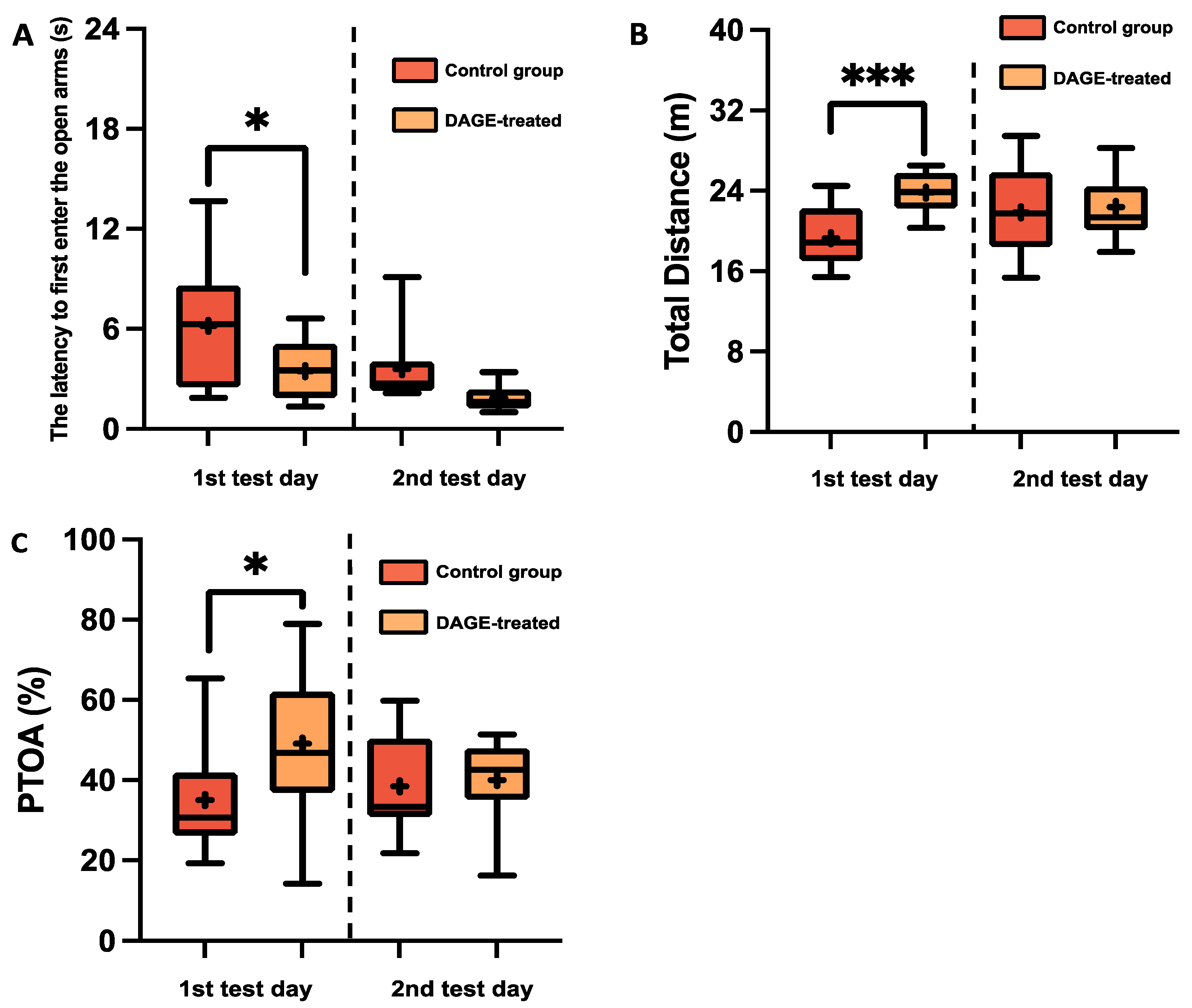
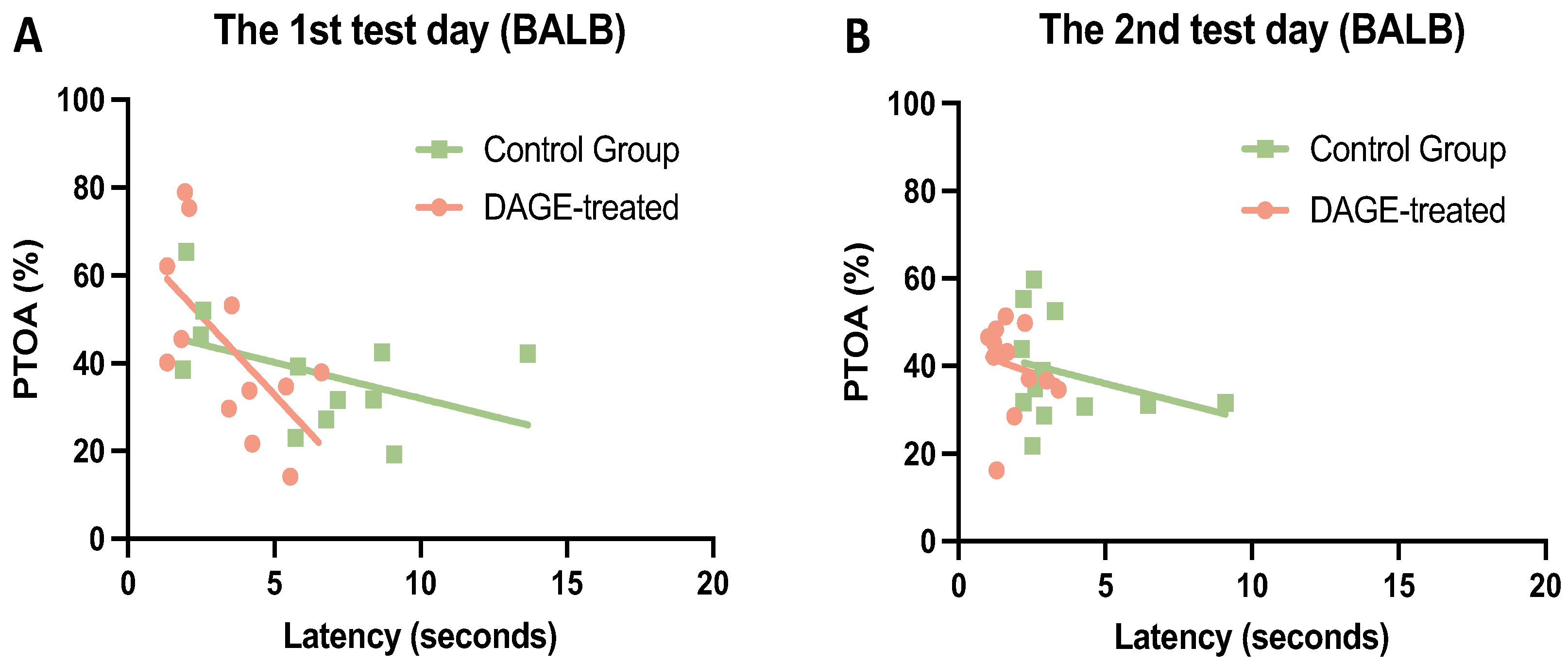
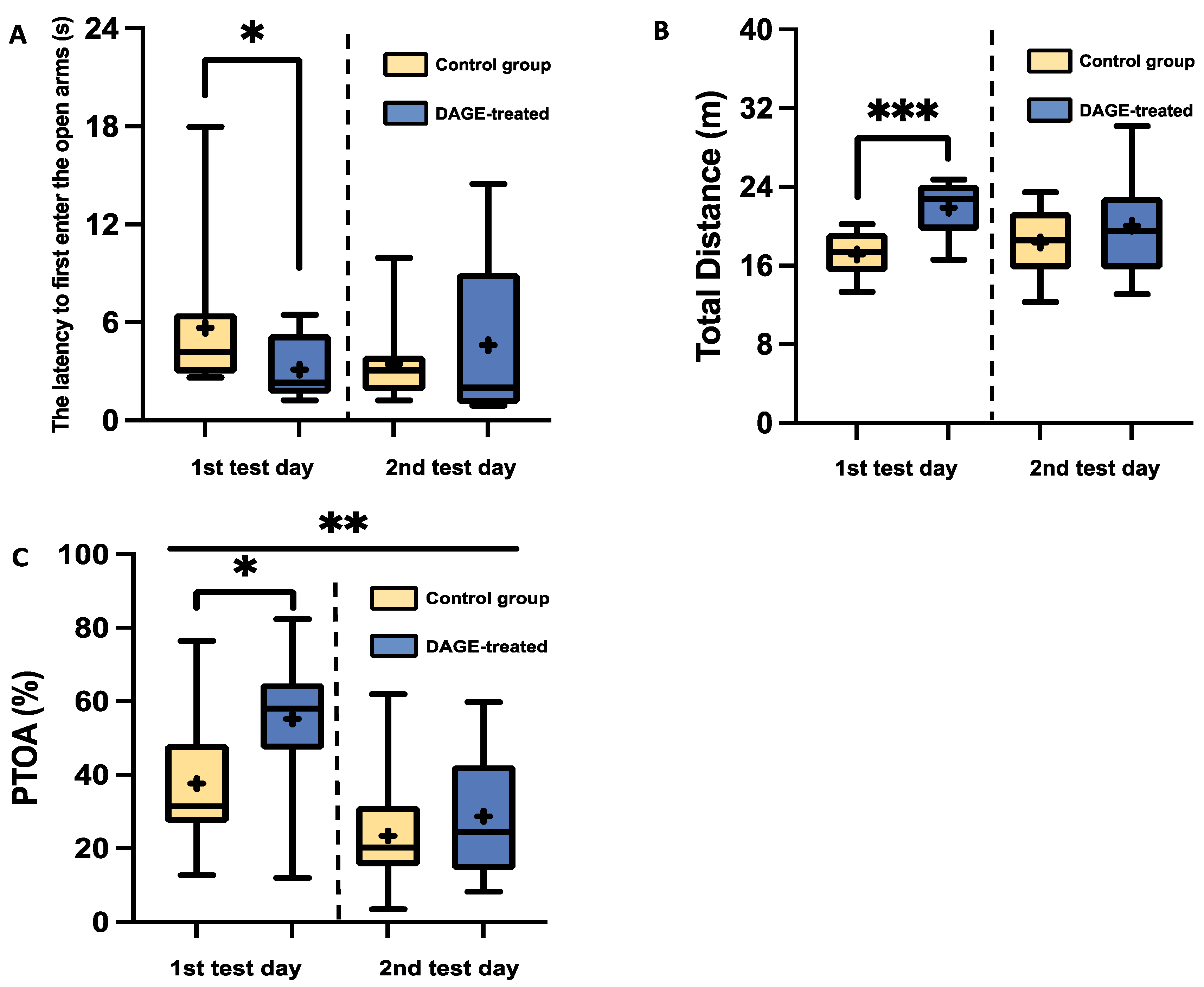
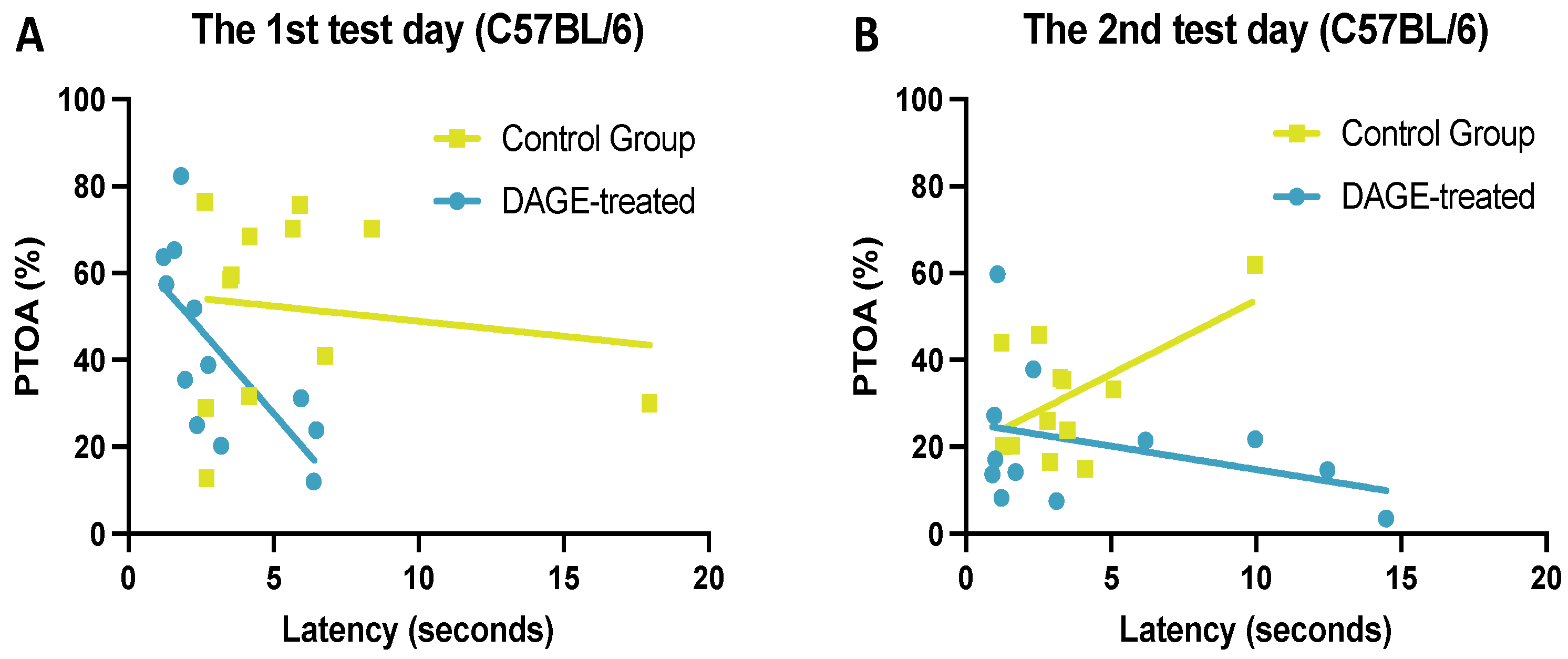
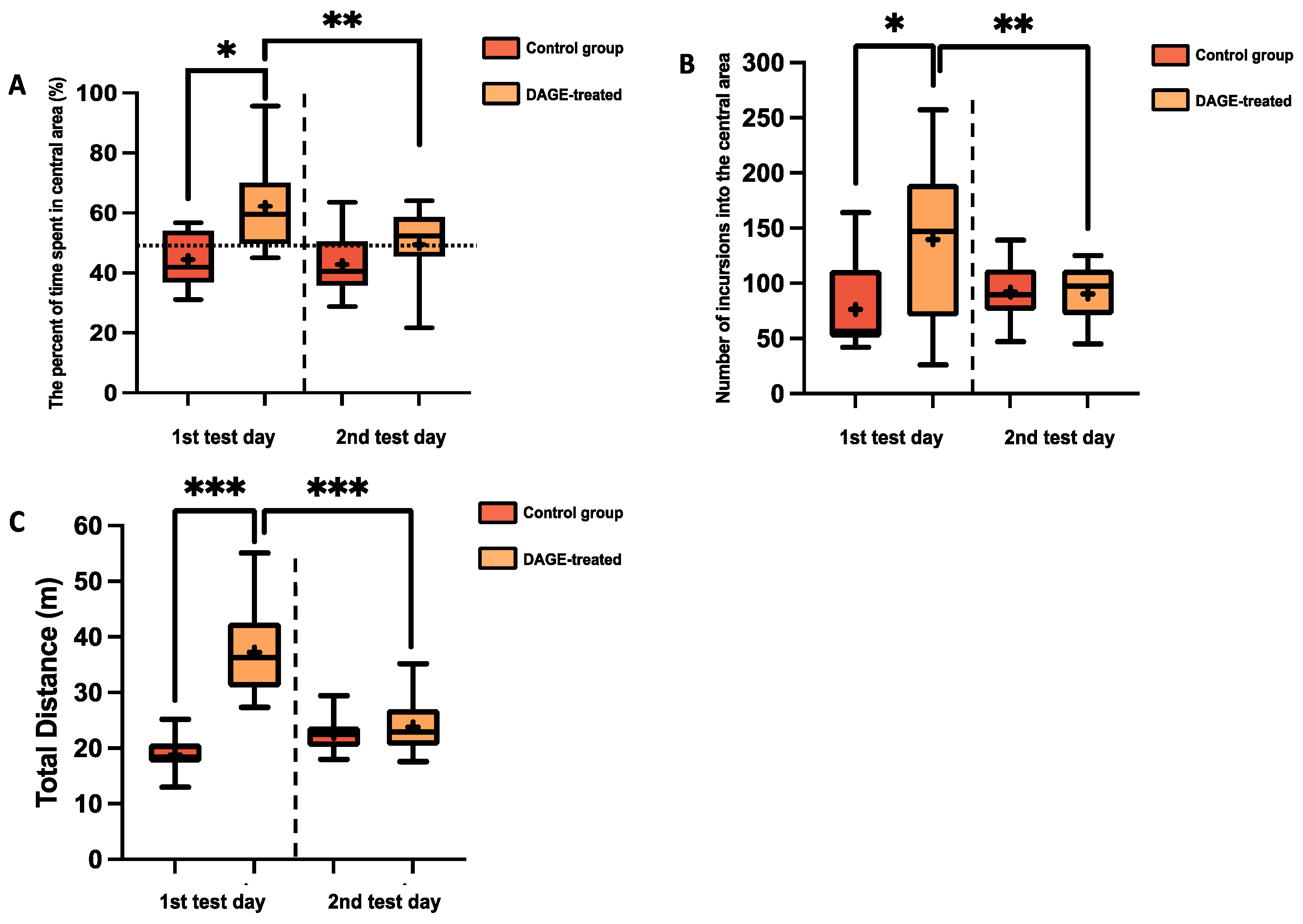
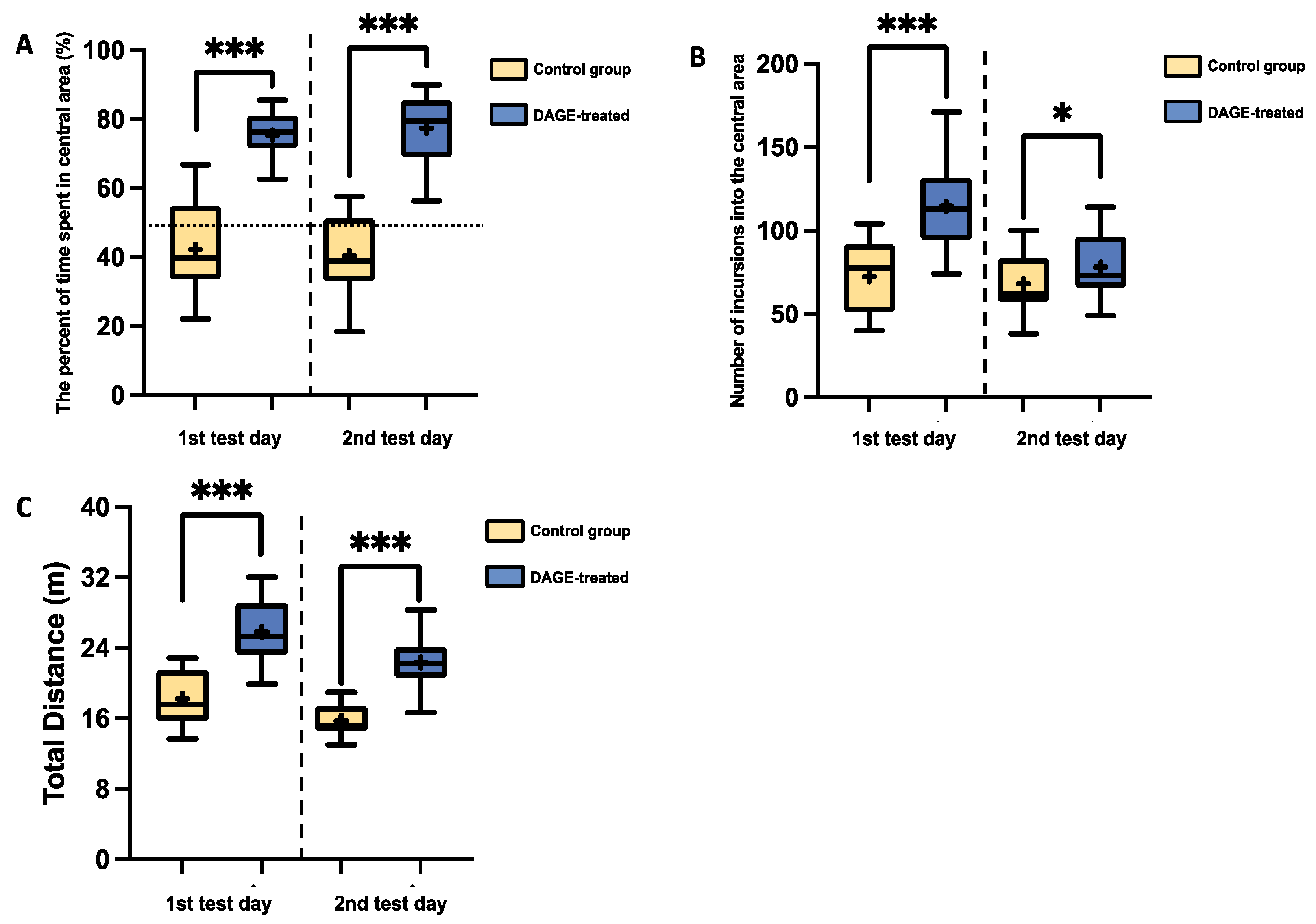
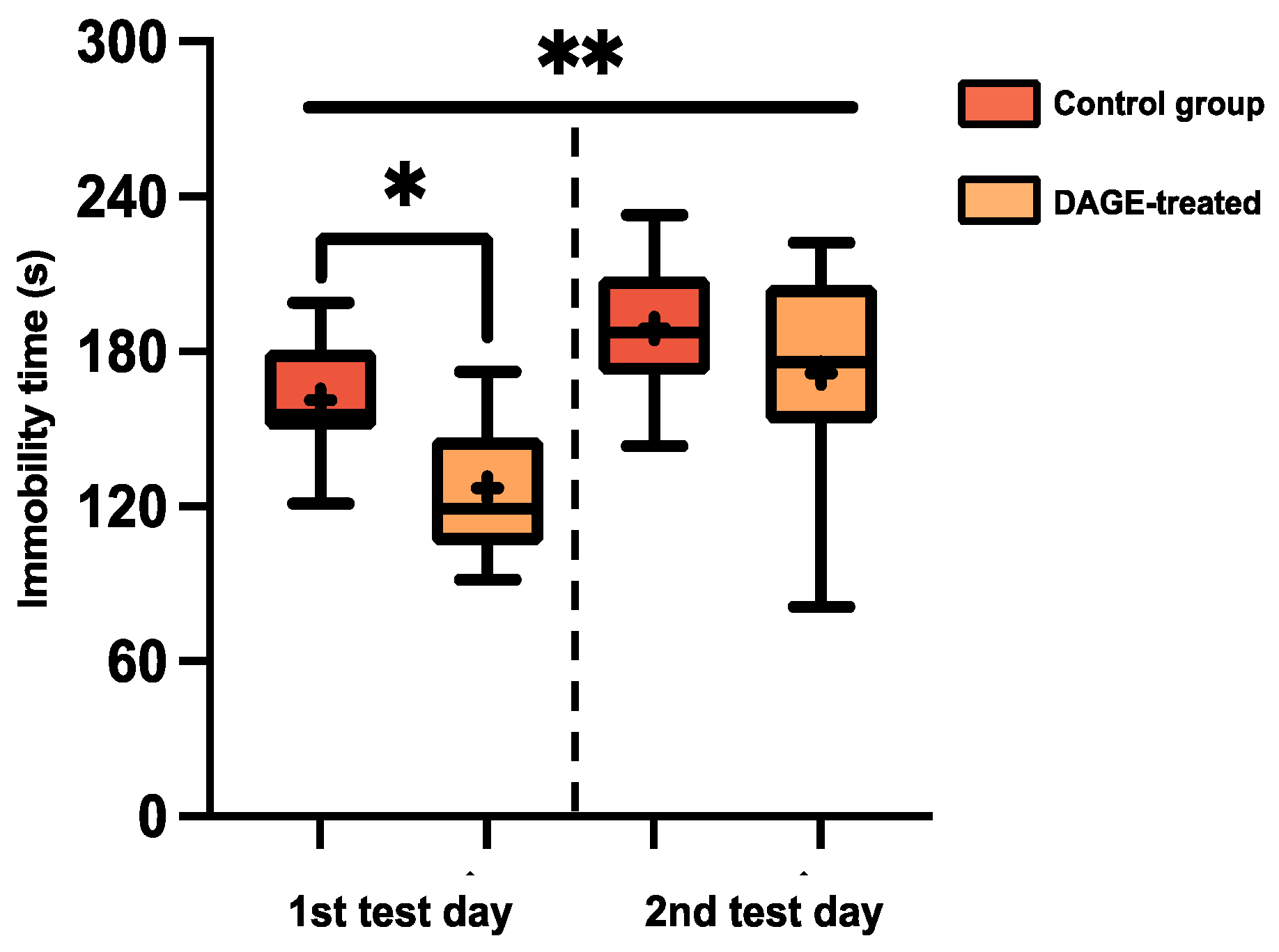
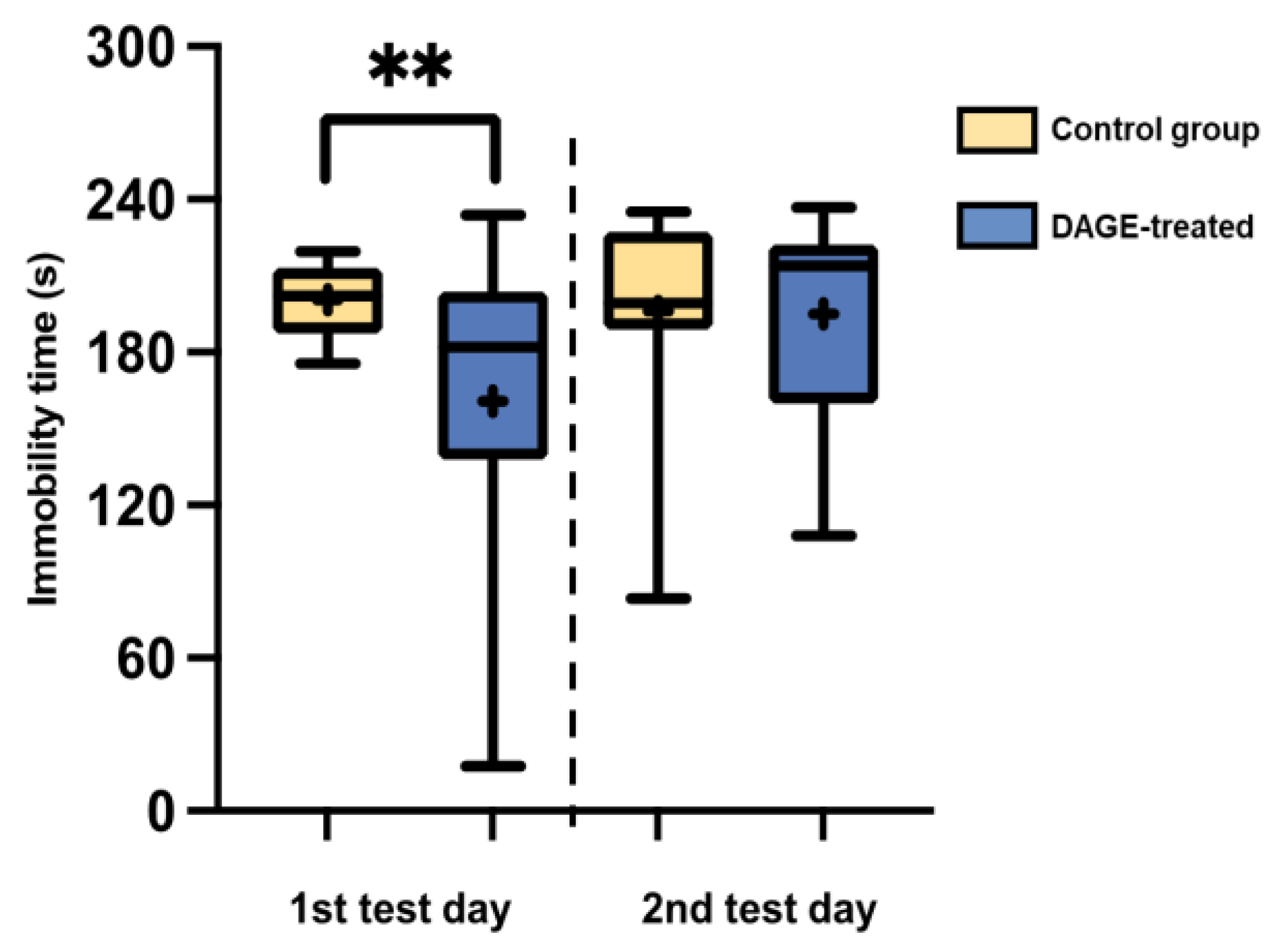
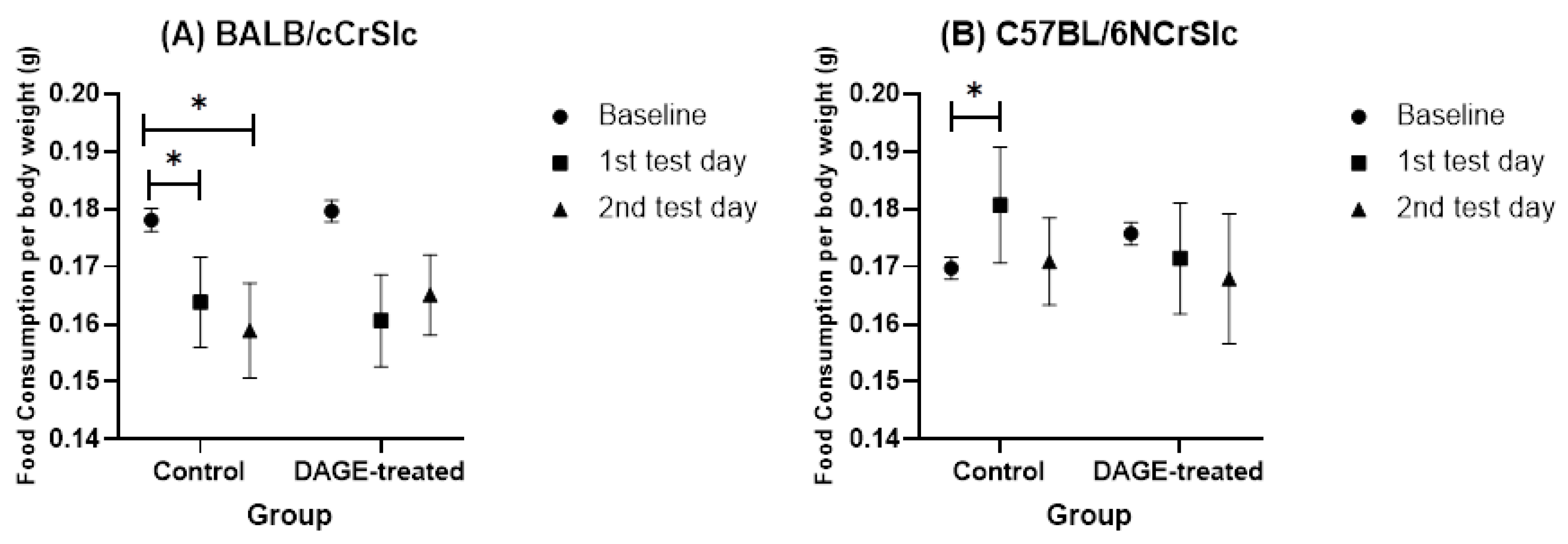
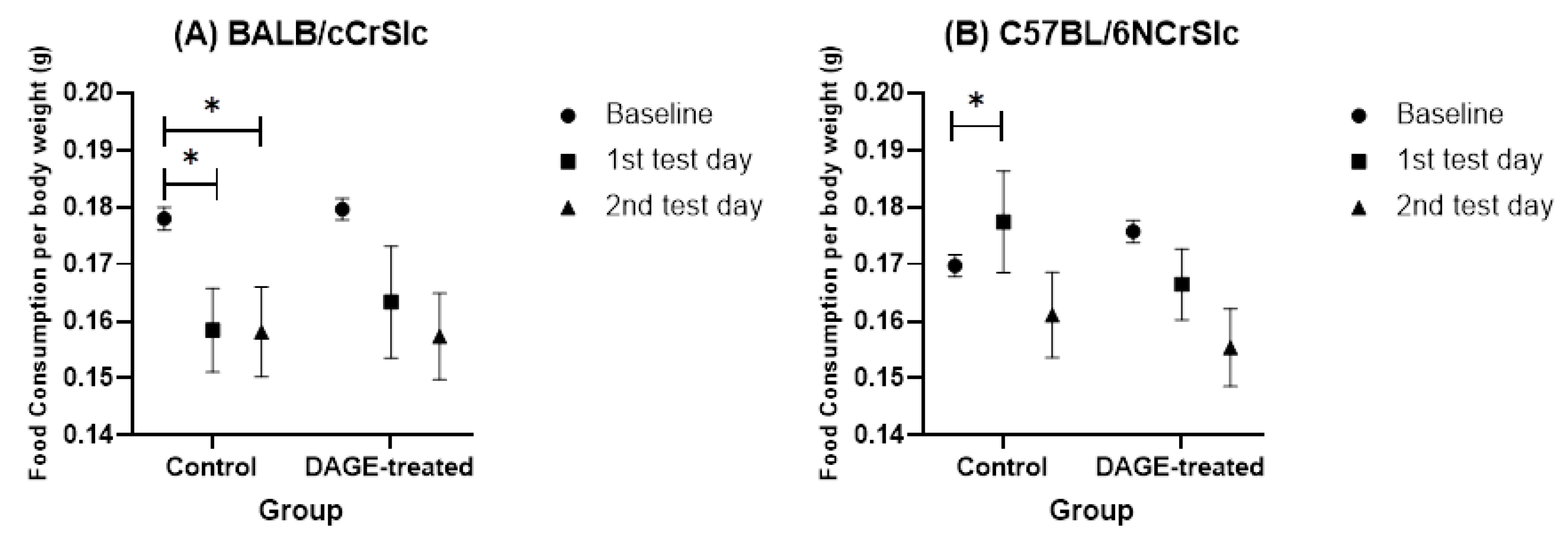
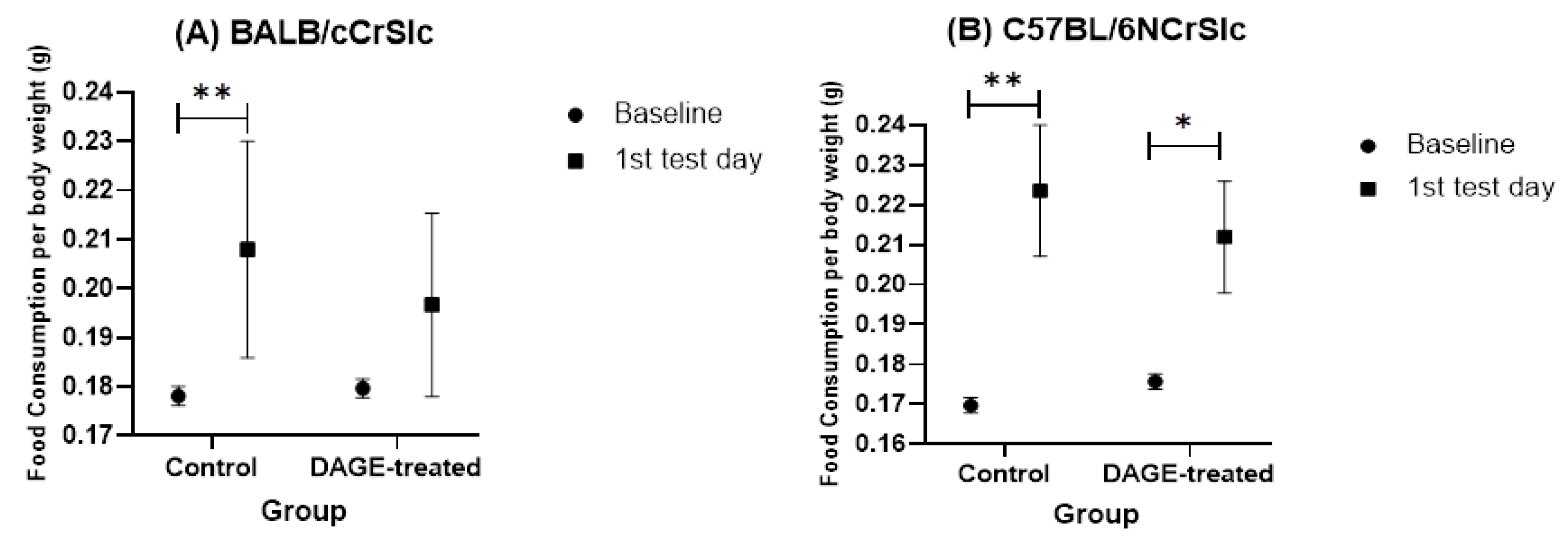
| DAGE Food | Control Food | |
|---|---|---|
| Composition | Basic formula: 94% (w/w) DAGE: 1.5% (w/w) Safflower oil: 4.5% (w/w) | Basic formula: 94% (w/w) Safflower oil: 6% (w/w) |
| Strain | Number of Mice | Treatment |
|---|---|---|
| BALB/cCrSIc | 12 | DAGE-enriched diet |
| BALB/cCrSIc | 12 | Control diet |
| C57BL/6NCrSIc | 12 | DAGE-enriched diet |
| BALB/cCrSIc | 12 | Control diet |
Disclaimer/Publisher’s Note: The statements, opinions and data contained in all publications are solely those of the individual author(s) and contributor(s) and not of MDPI and/or the editor(s). MDPI and/or the editor(s) disclaim responsibility for any injury to people or property resulting from any ideas, methods, instructions or products referred to in the content. |
© 2024 by the authors. Licensee MDPI, Basel, Switzerland. This article is an open access article distributed under the terms and conditions of the Creative Commons Attribution (CC BY) license (https://creativecommons.org/licenses/by/4.0/).
Share and Cite
Jiang, R.; Ohkubo, T.; Sato, T.; Sakai, N. Stress-Easing Effect of Diacyl Glyceryl Ethers on Anxiety-Related Behavior in Mice. Foods 2024, 13, 3765. https://doi.org/10.3390/foods13233765
Jiang R, Ohkubo T, Sato T, Sakai N. Stress-Easing Effect of Diacyl Glyceryl Ethers on Anxiety-Related Behavior in Mice. Foods. 2024; 13(23):3765. https://doi.org/10.3390/foods13233765
Chicago/Turabian StyleJiang, Rong, Takeshi Ohkubo, Toshihiko Sato, and Nobuyuki Sakai. 2024. "Stress-Easing Effect of Diacyl Glyceryl Ethers on Anxiety-Related Behavior in Mice" Foods 13, no. 23: 3765. https://doi.org/10.3390/foods13233765
APA StyleJiang, R., Ohkubo, T., Sato, T., & Sakai, N. (2024). Stress-Easing Effect of Diacyl Glyceryl Ethers on Anxiety-Related Behavior in Mice. Foods, 13(23), 3765. https://doi.org/10.3390/foods13233765







